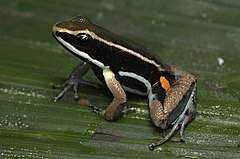Allobates femoralis
Allobates femoralis (common name brilliant-thighed poison frog, brilliant-thighed poison-arrow frog) is a species of frog in the family Aromobatidae.[2][3] It is found in Bolivia, Brazil, Colombia, Ecuador, French Guiana, Guyana, Peru, and Suriname. Its natural habitat is tropical lowland forests.
| Allobates femoralis | |
|---|---|
 | |
| Scientific classification | |
| Kingdom: | Animalia |
| Phylum: | Chordata |
| Class: | Amphibia |
| Order: | Anura |
| Family: | Aromobatidae |
| Genus: | Allobates |
| Species: | A. femoralis |
| Binomial name | |
| Allobates femoralis | |
 | |
| Distribution map | |
Description
Allobates femoralis is a small frog, the males growing to 28 to 33 mm (1.1 to 1.3 in) in length and the females being marginally larger. The back is dark brown or black and the limbs dark brown. The throat is black and the belly is white, variously marked with black. A pale brown dorso-lateral stripe runs from the snout to the base of the legs and an intermittent white ventro-lateral line runs from the snout to the arm and onwards to the leg. There is an orange-yellow patch behind the arm and a half-moon shaped orange patch on the outside of the thigh. A. femoralis resembles Lithodytes lineatus in general appearance, but the latter has a dorso-lateral line encircling the back, legs barred with dark and light bands of colour, and two or more orange patches on each thigh.[4]
Distribution and habitat
Allobates femoralis occurs in the Amazon Basin and tropical eastern South America. Its range includes Guyana, Suriname, French Guiana and Brazil, and the eastern parts of Colombia, Ecuador, Peru and Bolivia. A single reported sighting in Venezuela may have referred to Ameerega picta. It is found on the forest floor, usually at elevations below 300 m (1,000 ft), but in Colombia and Ecuador occurs at altitudes of up to 1,000 m (3,300 ft).[1]
Biology

Allobates femoralis is a terrestrial frog species active during the day. It feeds on small insects such as beetles, crickets, roaches and ants; the juveniles largely feed on springtails. Breeding takes place between November and April, peaking in January or February. The males are territorial and court females for two or three days before a clutch of between about eight to seventeen eggs is laid in a nest among fallen leaves. The male guards the eggs, and after they have hatched, he carries the tadpoles to pools of water on his back.[4]
Status
The IUCN lists Allobates femoralis as being of "Least Concern". This is because it has a wide range and is common throughout much of that range, it is tolerant of some degree of modification of its habitat, its population seems to be steady and no particular threats to it have been identified.
References
- Enrique La Marca; Claudia Azevedo-Ramos; Robert Reynolds; Luis A. Coloma; Santiago Ron (2010). "Allobates femoralis". IUCN Red List of Threatened Species. 2010: e.T55038A11244330. doi:10.2305/IUCN.UK.2010-2.RLTS.T55038A11244330.en.
- Frost, Darrel R. (2014). "Allobates femoralis (Boulenger, 1884)". Amphibian Species of the World: an Online Reference. Version 6.0. American Museum of Natural History. Retrieved 17 May 2014.
- Blackburn, D.C.; Wake, D.B. (2011). "Class Amphibia Gray, 1825. In: Zhang, Z.-Q. (Ed.) Animal biodiversity: An outline of higher-level classification and survey of taxonomic richness" (PDF). Zootaxa. 3148: 39–55.
- Albertina P. Lima; William E. Magnusson; Marcelo Menin; Luciana K. Erdtmann; Domingos J. Rodrigues; Claudia Keller; Walter Hödl (2013-02-15). "Allobates femoralis". AmphibiaWeb. Retrieved 2014-05-08.
| Wikimedia Commons has media related to Allobates femoralis. |
Further reading
- Pašukonis, A., et al. (2014). Homing trajectories and initial orientation in a Neotropical territorial frog, Allobates femoralis (Dendrobatidae). Frontiers in Zoology 11 29.
- Ringler, E., et al. (2013). Tadpole transport logistics in a Neotropical poison frog: indications for strategic planning and adaptive plasticity in anuran parental care. Frontiers in Zoology 10 67.
